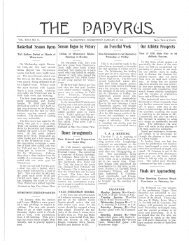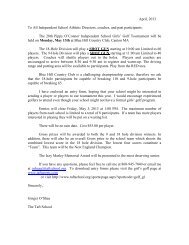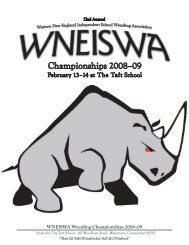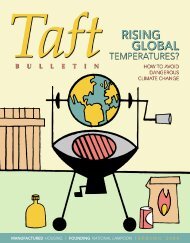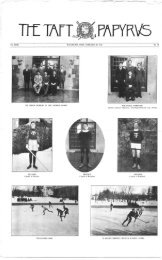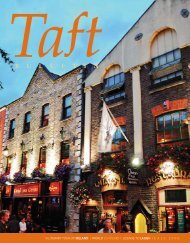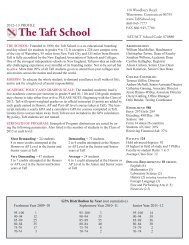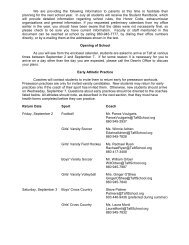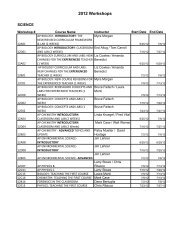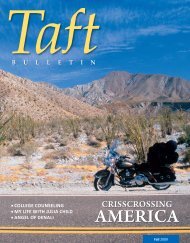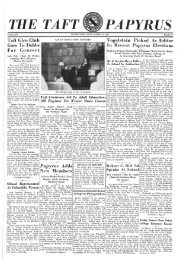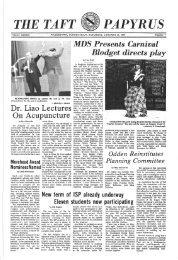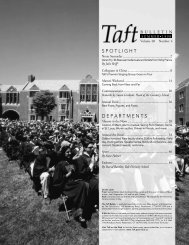B U L L E T I N Taft Portrait of a Graduate - The Taft School
B U L L E T I N Taft Portrait of a Graduate - The Taft School
B U L L E T I N Taft Portrait of a Graduate - The Taft School
- No tags were found...
Create successful ePaper yourself
Turn your PDF publications into a flip-book with our unique Google optimized e-Paper software.
GRETCHEN SAGAN<br />
An exquisite basket made <strong>of</strong> baleen<br />
March, visiting rural villages to purchase<br />
Native art objects. <strong>The</strong> only way to<br />
travel from checkpoint to checkpoint as<br />
a race bystander is by plane, snowmobile,<br />
or dogsled. Susan and her traveling<br />
companions opted for plane travel in a<br />
ski plane flown by Alaskan pilots Terri<br />
Smith, a foundation board member, and<br />
her husband Terry. Susan traveled the<br />
race route with founding board member<br />
Alice and her son, along with<br />
another friend and his son.<br />
<strong>The</strong> ceremonial start <strong>of</strong> the<br />
Iditarod race was in Anchorage. “I left<br />
32 inches <strong>of</strong> snow in Nantucket and<br />
flew to Anchorage where there was<br />
none!” she laughs. Since there was so little<br />
snow in Alaska this year, they trucked<br />
snow into the streets for the ceremonial<br />
start. <strong>The</strong> actual start <strong>of</strong> race was held<br />
later in Fairbanks. In fact, a whole new<br />
section <strong>of</strong> the course had to be created to<br />
provide a snow-covered route this year.<br />
<strong>The</strong> Iditarod mushers travel 1,100<br />
miles over mountain ranges, completing<br />
the race in anywhere from 10 to 14 days.<br />
Stopping points, mostly for the dogs to<br />
rest and be fed, can be 60 to 90 miles<br />
apart. Since mushers can’t carry all their<br />
supplies on their sled, the checkpoints <strong>of</strong>fer<br />
tents for sleeping, hay bedding<br />
outdoors for the dogs, dog food, plus<br />
many veterinarians who check every<br />
single dog (as the mushers also do).<br />
Entrants usually keep a schedule such<br />
as six hours mushing and six hours resting.<br />
Interestingly, there is no doctor for<br />
the mushers themselves who are lucky<br />
if they can sleep for one or two hours at<br />
each stop since dog care and dog rest<br />
are the priorities.<br />
Finding<br />
Native Artisans<br />
Flying to different checkpoints on the<br />
Yukon River, Susan and her colleagues<br />
met Native artists all along the race route<br />
in very rural villages where the population<br />
ranges from 100 to 650 people. She<br />
says that when they arrived in each town,<br />
the word quickly got out as to whom they<br />
were—no trouble finding the local artists<br />
as a result. In one village, a woman<br />
they nicknamed “the mayor,” an artisan<br />
Northern Exposure<br />
herself, had listened to a radio scanner<br />
so she quickly knew Susan’s group was<br />
flying in. <strong>The</strong> names <strong>of</strong> the villages they<br />
visited evoke a Native Alaskan culture<br />
that the rest <strong>of</strong> the U.S. knows little<br />
about: Kaltag, Unalakleet, Shaktoolik,<br />
Koyuk, Grayling, Eagle Island, and<br />
White Mountain.<br />
Susan and Alice purchased objects<br />
from the families <strong>of</strong> artisans they visited<br />
who sold the foundation beadwork,<br />
skinwork, and carved ivory. <strong>The</strong> foundation<br />
believes in paying fair and generous<br />
prices for the beautifully made works,<br />
knowing this is <strong>of</strong>ten the only source <strong>of</strong><br />
income for many rural Native people.<br />
“<strong>The</strong>y can’t go to K-Mart and buy a new<br />
pair <strong>of</strong> mittens,” Susan emphasizes.<br />
“<strong>The</strong>y’ll make them out <strong>of</strong> skins—there<br />
is no fabric store down the street.” Rural<br />
Native houses might be built <strong>of</strong> plywood<br />
and look as if they’re barely standing up,<br />
but ironically, she says, they <strong>of</strong>ten have a<br />
satellite dish outside.<br />
“As you travel and meet the Natives<br />
they have artwork in their pockets,” Susan<br />
states. “<strong>The</strong>y’ll pull a hand-carved object<br />
out <strong>of</strong> their pockets and say, ‘Do you like<br />
it’” She equates the rural Alaskan stores<br />
that sell everything from milk to snow<br />
shovels to eyeglasses, with Vermont<br />
country stores. “<strong>The</strong>re might be a little<br />
table with unbelievable artwork under<br />
glass. Someone will have made a polar<br />
bear carving from fossilized ivory and<br />
traded it for diapers,” she says. It’s a practical<br />
way to buy what they need and can’t<br />
make themselves.<br />
Hunting<br />
and Gathering<br />
Alaskan Native people still hunt and gather<br />
Susan points out. <strong>The</strong>y hunt and subsist<br />
on whale, walrus, moose, caribou, seal, and<br />
fish. <strong>The</strong> whole animal is used where possible.<br />
<strong>The</strong> village <strong>of</strong> Shishmaref in the far<br />
north is known for its fossilized ivory <strong>of</strong><br />
mastodon and wooly mammoth. Before<br />
<strong>Taft</strong> Bulletin Summer 2003<br />
37



